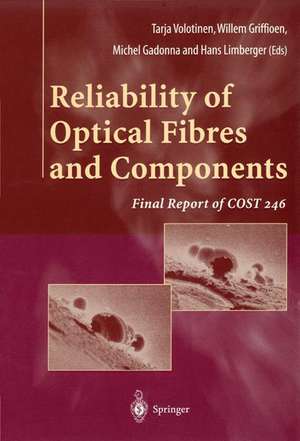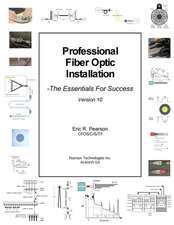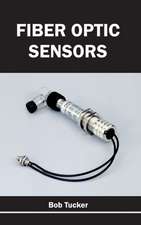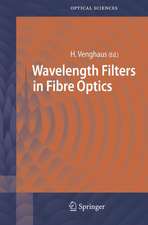Reliability of Optical Fibres and Components: Final Report of COST 246
W. Griffioen Editat de Tarja Volotinen Bernard Heens, Hanna Knuuttila Editat de Michel Gadonna Charles Kurkjian Editat de Hans G. Limberger Shehzad Mirza, Aleksander Opacic, Paola Regio, Sergei Semjonoven Limba Engleză Paperback – 27 mai 1999
Preț: 951.59 lei
Preț vechi: 1160.48 lei
-18% Nou
Puncte Express: 1427
Preț estimativ în valută:
182.09€ • 194.71$ • 151.82£
182.09€ • 194.71$ • 151.82£
Carte tipărită la comandă
Livrare economică 18 aprilie-02 mai
Preluare comenzi: 021 569.72.76
Specificații
ISBN-13: 9781852331474
ISBN-10: 185233147X
Pagini: 444
Ilustrații: XX, 423 p.
Dimensiuni: 155 x 235 x 23 mm
Greutate: 0.62 kg
Ediția:Softcover reprint of the original 1st ed. 1999
Editura: SPRINGER LONDON
Colecția Springer
Locul publicării:London, United Kingdom
ISBN-10: 185233147X
Pagini: 444
Ilustrații: XX, 423 p.
Dimensiuni: 155 x 235 x 23 mm
Greutate: 0.62 kg
Ediția:Softcover reprint of the original 1st ed. 1999
Editura: SPRINGER LONDON
Colecția Springer
Locul publicării:London, United Kingdom
Public țintă
Professional/practitionerDescriere
Reliability of Optical Fibres and Components reports the findings of COST 246 (1993-1998) - European research initiative in the field of optical telecommunications. Experts in the materials and reliability field of optical fibres and components have contributed to this unique study programme. The results, conclusions and achievements of their work have been obtained through joint experimentation and discussion with representatives from manufacturing and research groups. Topics covered include:
• lifetime estimation;
• failure mechanisms;
• ageing test methods;
• field data and service environments for components.
For the first time the reader can explore the reliability of products and examine the results and conclusions in published form. This comprehensive volume is intended to provide a deeper understanding of the reliability of optical fibres and components. The book will be extremely useful to all scientists and practitioners involved in the industry.
• lifetime estimation;
• failure mechanisms;
• ageing test methods;
• field data and service environments for components.
For the first time the reader can explore the reliability of products and examine the results and conclusions in published form. This comprehensive volume is intended to provide a deeper understanding of the reliability of optical fibres and components. The book will be extremely useful to all scientists and practitioners involved in the industry.
Cuprins
1. Introduction and General Information about COST and the COST 246 Action.- 1.1. COST Framework.- 1.2. Technical Description of COST 246 Action.- 1.3. Objectives.- 1.4. Working Groups, Study Groups and Their Tasks.- 1.5. Methods of Working.- 1.6. Meetings and Workshops.- 1.7. Dissemination of the Results and Achievements.- 1.7.1. Publications and Reports.- 1.7.2. Web Site.- 1.7.3. Scientific and Technical Cooperation.- 1.7.4. Transfer of Results.- 1.8. Economic Dimension.- 2. Reliability of Optical Fibres and Components.- 2.1. Introduction, Reliability.- 2.1.1. Reliability Function, Survival Probability.- 2.1.2. Failure Function, Failure Probability.- 2.1.3. Probability Density Function (Failure Probability per Unit Time).- 2.1.4. Failure Rate.- 2.1.5. Proof Test.- 2.1.6. Lifetime.- 2.1.7. Statistical Methods and Parameters.- 2.1.8. Time to Failure and between Failures.- 2.1.9. Mean Time to Repair.- 2.1.10. Network Reliability.- 2.2. How to Study Reliability and Estimate Lifetime of New Components.- 2.2.1. Performance Tests.- 2.2.2. Reliability Tests.- 2.3. Standards for Optical Fibre, Component and Network Reliability.- 2.3.1. Background.- 2.3.2. Standards Groups and Reliability.- 2.4. References.- Annex 2.A Impact of Fibre Lifetime on Network Reliability.- 3. Optical Fibres (WG1.1).- 3.1. Contributors.- 3.2. Introduction.- 3.2.1. Mechanical Reliability Studies on Fibres.- 3.2.2. Fibre Strength Distribution, Fatigue, Ageing and Lifetimes.- 3.2.3. Studies on Optical Transmission Aspects.- 3.3. Objectives.- 3.4. Working Methods.- 3.5. Output of WG1.1.- 3.5.1. Summary.- 3.5.2. Fibre Splicing, Connecting and Handling (e.g. for Passive Components and Fibre Bragg Gratings).- 3.5.3. “Pop-in” Phenomena.- 3.5.4. Service Conditions for Optical Fibres in US and Europe.- 3.5.5. Co-ordination with COST 239 and 241.- 3.6. Presentations at WG1.1 Meetings.- 3.6.1. Ageing of Fibres.- 3.6.2. Polarisation Mode Dispersion during Ageing.- 3.6.3. Smallest Allowable Bend Diameter.- 3.6.4. Mechanical Properties of Weak Spots.- 3.6.5. Coating Characterisation and Ageing Behaviour.- 3.7. Achievements and Conclusions.- 3.8. Prospects and Future Work.- Annex 3.A Strength Degradation of Lightguide Fibres in Room Temperature Water.- Annex 3.B Influence of the Coating in Mechanical Behaviour of Aged Optical Fibres.- 4. Handleability of Aged Fibres (WG1.1 SG1).- 4.1. Contributors.- 4.2. Introduction.- 4.3. Objectives.- 4.4. Working Methods.- 4.5. Output of SG1.- 4.6. Achievements and Conclusions.- 4.7. References.- Annex 4.A Handleability of Aged Optical Fibres.- 5. Ageing Tests (WG1.1 SG2).- 5.1. Contributors.- 5.2. Introduction.- 5.3. Objectives.- 5.4. Working Methods.- 5.5. Output of SG2.- 5.5.1. Summary.- 5.5.2. Results of the 1st Round Robin.- 5.5.3. Results of the 2nd Round Robin.- 5.5.4. Discussion on the Possible Standard Method.- 5.6. Presentations at SG2 Meetings.- 5.6.1. Fibre Ageing.- 5.6.2. Ageing Environment.- 5.6.3. Testing the Aged Fibres.- 5.7. Achievements and Conclusions.- 5.8. References.- Annex 5.A Effect of Water Quality and Quantity on Strength Degradation of Fused Silica Fibre in Water Tests.- Annex 5.B High-Temperature Ageing of Modern Polymer-Coated Optical Fibers.- 6. Fusion Splices Reliability(WG1.1 SG3).- 6.1. Contributors.- 6.2. Introduction.- 6.3. Objectives.- 6.4. Working Methods.- 6.5 Output of SG3.- 6.5.1. Summary.- 6.5.2. Questionnaire.- 6.6. Presentations at SG3 Meetings.- 6.6.1. Effect of Mechanical Stripping and Arc-Fusion on the Strength and Ageing of a Spliced Re-coated Optical Fibre (Annex 6.B).- 6.6.2. High Yield Fusion Splicing in the Outside Plant: Using Fibre Metlpack to Monitor Electrode Condition.- 6.6.3. Active Optical Monitoring of Spliced Ribbons during Fibre Retention testing: Apparent and Real Splice Strength..- 6.6.4. Measurements on 8-Fibre Ribbons and Fusion Splices (Annex 6.A).- 6.6.5. Mechanical Strength and Fatigue of Optical Fibre Fusion Splices.- 6.7. Achievements and Conclusions.- 6.9. References.- Annex 6.A Measurements on 8 Fibres Ribbons and Fusion Splices.- Annex 6.B Effect of Mechanical Stripping and Arc-Fusion on the Strength and Ageing of a Spliced Recoated Optical Fiber.- 7. Lifetime Estimation and B-Value (WG1.1 SG4).- 7.1. Contributors.- 7.2. Introduction.- 7.3. Objectives.- 7.4. Working Methods.- 7.5. Output of SG4.- 7.5.1. Summary.- 7.5.2. Questionnaire Sent to SG4 Members after the Meeting in Copengahen (March 1997).- 7.5.3. Results of the First Meeting in Lannion (July 1997).- 7.5.4. The Questionnaire and the Answers from the Editors of Document No-17.- 7.5.5. The Second Answer Sent to IEC after the Meeting in Brussels.- 7.5.6. The Final Answer to IEC.- 7.5.7. Conclusions on Lifetime Estimation and B-Value.- 7.6. Presentations at SG4 Meetings.- 7.6.1. B-Value and Its Measurements.- 7.6.2. Weak Spots and Their Behaviour.- 7.7. Achievements and Conclusions.- 7.8. Prospects and Future Work.- 7.9. References.- Annex 7.A A Compression Proposal to IEC Power-Law Document (IEC SC86A/WG1 Document No-17).- Annex 7.B Mechanical Behavior and B-Value of an Abraded Optical Fiber.- Annex 7.C Modelling of Proof Test Level Flaws using Cube Corner Indents.- 8. Cables and Outside- Plant Components (WG1.2).- 8.1. Contributors.- 8.2. Introduction.- 8.3. Objectives.- 8.4. Working Methods.- 8.5. Output of WG1.2.- 8.5.1. Summary.- 8.5.2. Ducts Flooding with water.- 8.5.3. Freezing Water.- 8.5.4. Hydrogen in Cables.- 8.5.5. Reliability of Cable Materials.- 8.5.6. Recycled Materials for Ducts.- 8.5.7. Duct Cups.- 8.5.8. Fibre Stress.- 8.5.9. Guidance of Fibre Loops/Attachment Cables.- 8.5.10. Effect of Cable Installation Technique.- 8.5.11. Other Problems.- 8.5.12. Service Environment of Optical Fibres in Telecommunications Networks.- 8.6 Presentations at WG1.2 Meetings.- 8.6.1. Installation of Cables in Ducts.- 8.6.2. Reliability of jelly-Filled Poly-Propylene Slotted-Cores.- 8.6.3. Distributed Stresses in Optical Fibres Measured Using Local Brillouin Scattering Analysis.- 8.6.4. Flashovers Cause Primary Failures in Slotted Core Optical Fibre Cables Having Metallic Strength Member.- 8.6.5. Hydrogen Consideration for Optical Cables.- 8.6.6. Hydrogen Balance in Cables.- 8.6.7. Brillouin Scattering Stress Measurements.- 8.6.8. Summary of Cable problems with Freezing Water in Ducts.- 8.6.9. Summary of the Closure Problem with Aerial Cables.- 8.6.10. Reliability of Plastic Materials.- 8.6.11. Residual Fibre Stress After Installation.- 8.6.12. A copper-in-tube Access Network, Ease to Migration to Optical Fibre.- 8.6.13. Future Proof and Reliable Fibre Optic Outside Plant Products for the Access Network.- 8.7. Achievements and Conclusions.- 8.8. Prospects and Future Work.- 8.9. References.- Annex 8.A Results from Questionnaire, Outside Plant Configurations and Weakest Points.- Annex 8.B Results from Questionnaire, Service Environmental Conditions for Fibres and Optical Components in Cable Networks.- 9. Connecting and Branching Components (WG2).- 9.1. Contributors.- 9.2. Introduction.- 9.3. Objectives.- 9.4. Working Methods.- 9.5. Output of WG2.- 9.5.1. Summary.- 9.5.2. Service Environments for Passive Optical Components.- 9.5.3. Reliability Model and Calculating Procedures.- 9.5.4. Definition of the Reliability Test Program.- 9.5.5. Test Procedures and Results.- 9.6. Presentations at WG2 Meetings.- 9.6.1. Passive Optical Splitters.- 9.6.2. Plastic Optical Fibres and Optical Waveguides in Poly-Methyl-Meth-Acrylate (PMMA).- 9.6.3. Field Experiences with Passive Components in Different Countries.- 9.6.4. Quality and Reliability Tests on Fibre Optic Connectors.- 9.7. Achievements and Conclusions.- 9.8. Prospects and Future work.- 9.9. References.- 10. Fibre Bragg Grating Components (WG4).- 10.1. Contributors.- 10.2. Introduction.- 10.3. Objectives.- 10.4. Working Methods.- 10.5. Output of WG4.- 10.5.1. Summary.- 10.5.2. Results of FBG Questionnaire.- 10.5.3. FBG Characterisation.- 10.5.4. Environmental Conditions.- 10.5.5. Mechanical Resistance and FBG Lifetime.- 10.5.6. Results on High Temperature Measurements.- 10.6. Achievements and Conclusions.- 10.7. Prospects for the Bragg Gratings Activities.- 10.8. References.- App. 1 List of publications of COST 246.- App. 2 COST 246 Participant Index with contact addresses.- App. 3 MoU of COST 246.- App. 4 Information of COST Framework and Telecommunications.
Caracteristici
The first of its kind to look at the reliability of products and show their results and conclusions in published form
The research group brings together many institutes and companies totalling 70 people in this research initiative
The research group brings together many institutes and companies totalling 70 people in this research initiative














